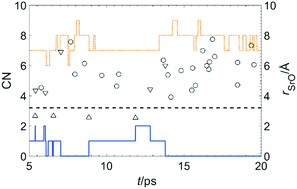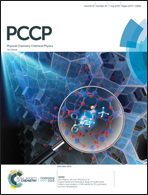Ab initio molecular dynamics studies of hydroxide coordination of alkaline earth metals and uranyl†
Abstract
Ab initio molecular dynamics (AIMD) simulations of the Mg2+, Ca2+, Sr2+ and UO22+ ions in either a pure aqueous environment or an environment containing two hydroxide ions have been carried out at the density functional level of theory, employing the generalised gradient approximation via the PBE exchange–correlation functional. Calculated mean M–O bond lengths in the first solvation shell of the aquo systems compared very well to existing experimental and computational literature, with bond lengths well within values measured previously and coordination numbers in line with previously calculated values. When applied to systems containing additional hydroxide ions, the methodology revealed increased bond lengths in all systems. Proton transfer events (PTEs) were recorded and were found to be most prevalent in the strontium hydroxide systems, likely due to the low charge density of the ion and the consequent lack of hydroxide coordination. For all alkaline earths, intrashell PTEs which occurred outside of the first solvation shell were most prevalent. Only three PTEs were identified in the entire simulation data of the uranium dihydroxide system, indicating the clear impact of the increased charge density of the hexavalent uranium ion on the strength of metal–oxygen bonds in aqueous solution. Broadly, systems containing more charge dense ions were found to exhibit fewer PTEs than those containing ions of lower charge density.



 Please wait while we load your content...
Please wait while we load your content...